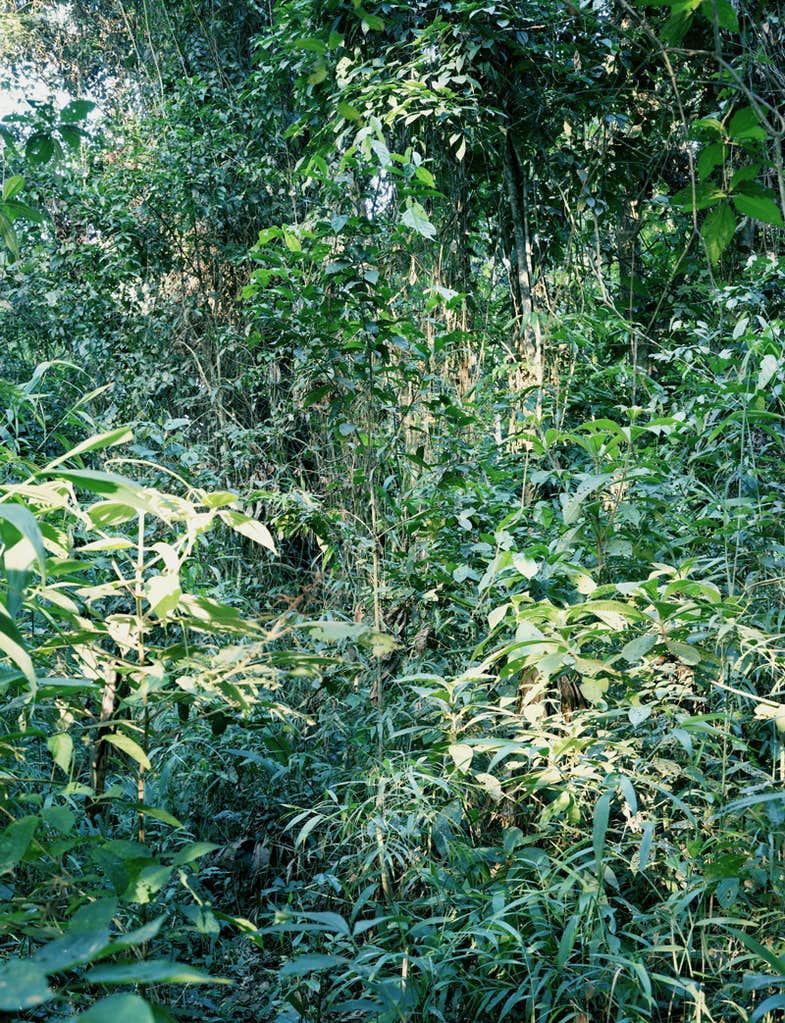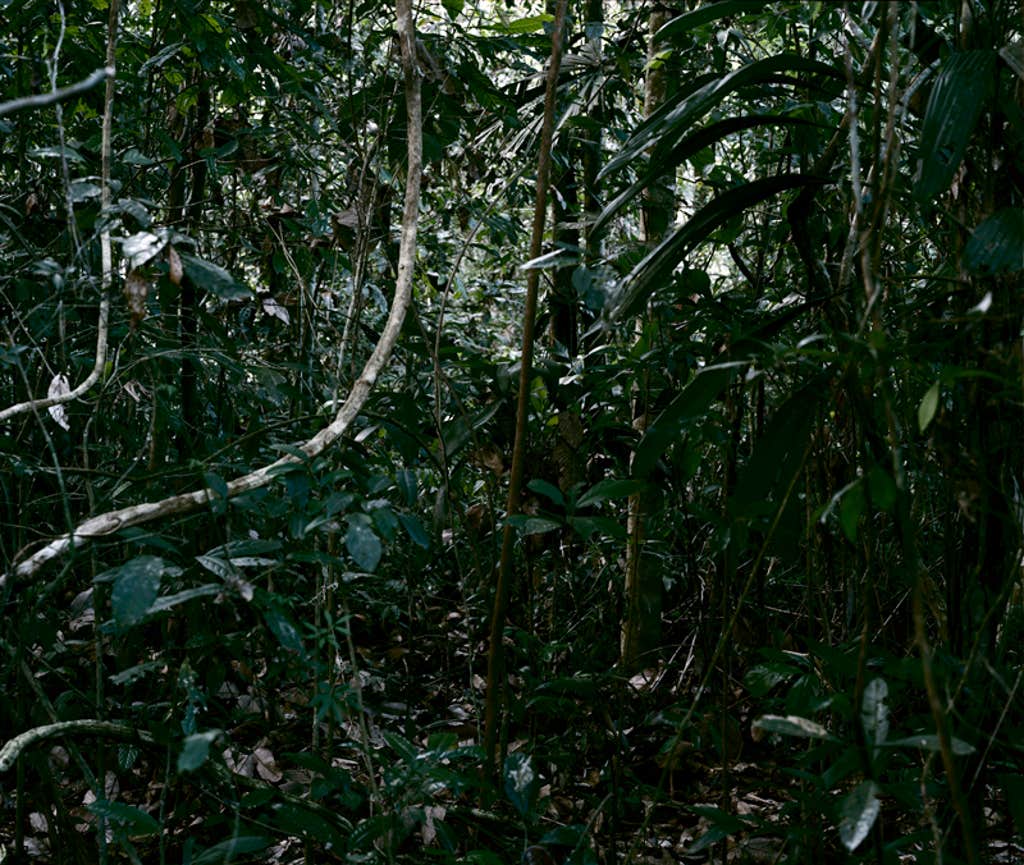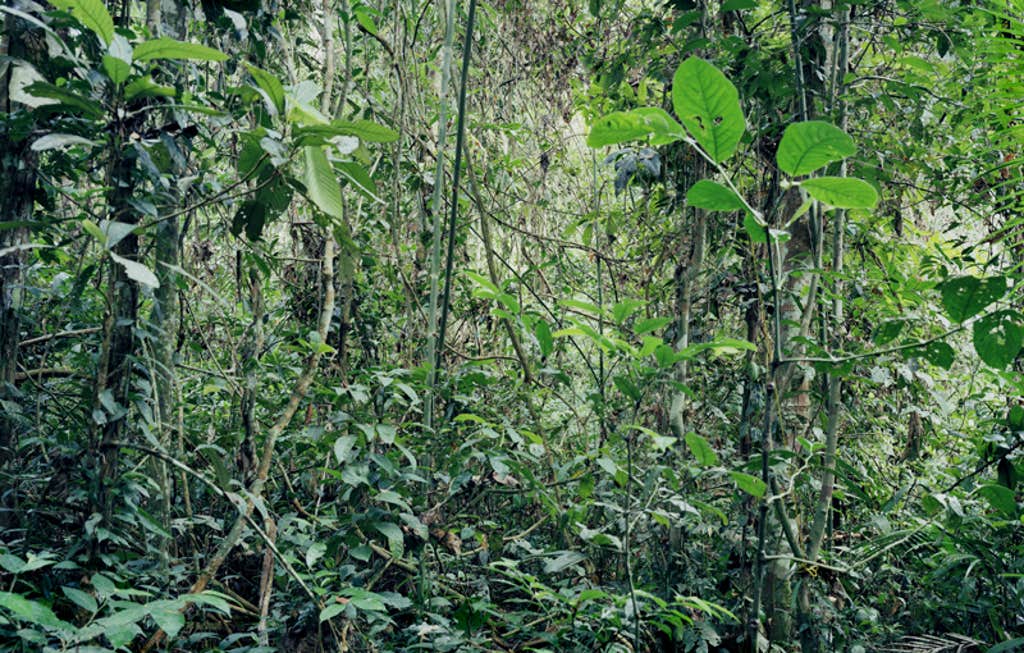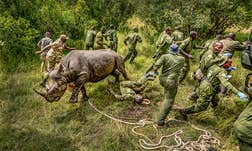For many years I ran a field station in Amazonian Peru. The station was a five-hour canoe ride from the nearest road, and every Friday our boat made the long trip upriver carrying crates of groceries, drums of gas for the generator, a mountain of scuffed-up backpacks and duffel bags, and the latest crop of scientists. The station buildings sat on a high bluff that looked a long way down the river, and late Friday afternoon I would begin to hear the buzz of the outboard motor when the boat was still a tiny comet-shaped object rounding the farthest bend. By the time I made it down the long wooden stairway to the riverbank, the sunburnt boat driver was pulling in with his sunburnt passengers.
Of the thousands of people who stepped off that boat during my time at the station—ornithologists, limnologists, philanthropists, schoolchildren, gold miners, filmmakers—one I still puzzle over with some regularity is Thomas Struth, a fine art photographer who worked at the station for a few days in 2005. I had never heard of Struth, but I had seen enough photographers come through the station to know they were usually looking for something specific. Struth seemed different. On his first day I showed him a map of the area and pointed out some of the most photogenic sites around camp. He replied in a quiet way that those places sounded very interesting and that he would very much like to visit them, but that he would probably not take his camera. At first I understood it to be a logistical problem, because he was traveling with a camera the size of a suitcase. But that wasn’t the reason at all.
You looked into a forest understory and your brain started casting about for something to grab onto.
He was after something else. For a long time I didn’t understand what it was, and he and his assistant couldn’t explain it to me, apart from observing in stilted English that they were “searching for complexity.” I gave them a trail map and left them to their own devices. It was no skin off my nose. I had plenty of other things to keep me busy at the station, including a shortage of roof thatch, a pile of unanalyzed data, half a dozen underperforming solar panels, a 2-year-old, and an infant.
Then there were the scientists. Some of them were there because they had a newfangled notion about white-lipped peccaries, whereas others wanted to know which flowers a particular butterfly fed on in the dry season, and all of us were burning to write up whatever we learned in some technical journal that, years later, an associate professor might glance at on his coffee break. We even had some honest-to-God eccentrics on hand, including a primatologist who had over the years piled up in her cabin what was surely, at that time, the most comprehensive collection in the southern hemisphere of Soap Opera Weekly. Now someone wanted to take pictures of complexity. Shrug—back to the laptop in my cabin—because there were more of these people coming next week, and they needed someone to tell them where to get on the boat.

I might never have figured out who Struth was and what he was doing at the station if he hadn’t offered to give a talk about his work in our weekly lecture series. Lectures were held in the dining room, after the dinner dishes had been cleared away. We had a fancy projector that looked out of place in the middle of the Amazon, and one of those screens that rolls up like a window shade. When everything went smoothly it felt like you were attending a lecture at the Museum of Comparative Zoology. When things did not go smoothly we lit candles and slapped at mosquitoes until Leo got the generator running again.
Struth started the talk by showing a selection of his best-known photographs, a half-dozen images that are familiar to museumgoers around the world. He was facing a tough crowd, though. Most of the people in the audience that night were museumgoers, but we had been going to a different kind of museum—the kind in Lima or Cusco where the night watchman lets you in after hours so that you can sit up late surrounded by stacks of pressed plants, trying to decipher your handwriting in a muddy field book, where the Plaster-of-Paris dinosaur in the foyer is missing a foot, the doorjambs are covered with schoolboys’ initials, and the cleaning lady hasn’t had a raise in years. Most of the audience would have felt more comfortable in a lecture on the phytogeography of the nutmeg family. As we sat there in the tropical night looking at Struth’s pictures—looking at pictures of parked cars in Düsseldorf; looking at pictures of tourists in the Louvre; looking, for Christ’s sake, at a German family in their living room—we couldn’t help but wonder what on Earth had prompted us that evening to saunter over to the grimy median that separates art from science and see what was happening on the other side. The pictures kept coming. Through the window we could see our colleagues over in the lab building: the happy ones who had chosen to skip the lecture and were contentedly measuring out formalin into tuna fish cans.
Struth, for his part, was also ill at ease. For one thing, in the dark dining room the lit-up projector screen was attracting moths. This was never much of a problem during scientific talks, when anything that landed on the screen provided some decoration to the log-scale axes. But the photographs Struth was showing seemed to focus on stillness, and they were images that he knew down to the finest detail, and he must have found it unsettling to discover a ctenuchid moth fluttering in their corners. Time after time Struth would call up a new photo, step back to appreciate it, and then rush in, arms waving, to scare off a moth. Some of the moths would take flight, and some of the moths would stay where they were. Some turned out not to be moths at all but brown spots left behind by the cockroaches that inhabited the screen between lectures.

Eventually he got to a series he was calling “Paradise.” These were photographs he had been taking in forests around the world—and the reason he was visiting the station. They made the biologists in the audience sit up straighter. Here, at last, was something that made sense. But soon enough the audience started to slump again. For every picture that earned an appreciative “mmmmm” because it looked beautiful or seemed meaningful, three or four clicked past in awkward silence because they weren’t pretty and felt pointless. The scenes of tangled vegetation that Struth had sought out were not necessarily beautiful or symmetrical, not blessed with remarkable lighting or visually striking objects or any kind of grandeur. They were not the kind of thing that your brain could easily tell itself a story about. You looked into a forest understory crisscrossed with vines and shadowed with branches and palm fronds and your brain started casting about for something to grab onto—some way in. Then that picture was gone and you were staring at the next, and it started all over again.
Struth had given up worrying about the moths. Most likely he had noted the audience’s unease, and perhaps he was even enjoying it. None of us knew it at the time, but in an interview a few years earlier he had said of the “Paradise” photographs, “One can spend a lot of time in front of these pictures and remain helpless in terms of knowing how to deal with them.”
Finally the slideshow was over. The lights came on, Struth said a quiet thanks, and the audience clapped half-heartedly. He hadn’t shown any of the photographs he’d taken at the station, and he hadn’t said very much about the pictures he had shown. As the scientists filed out of the dining room there was some head-shaking, and I realized that my colleagues were angry at me for having dragged them to such a flaky event. A mammalogist whispered accusingly, “What the fuck was that?”
I wasn’t sure. But there was plenty going on at the station that month, and soon enough Struth and his assistant had packed up their things and left, and we moved onto the next thing. A few months later I was eating lunch with a newly arrived researcher. When I happened to mention Struth’s visit, she dropped her fork. The last time she visited the Metropolitan Museum of Art, she said, there had been one enormous banner across the facade that said LEONARDO DA VINCI, another enormous banner that said GENGHIS KHAN, and a third enormous banner that said THOMAS STRUTH.
I dropped my fork, too. As my dictionary says: “struth, interj. A mild oath used to express surprise or dismay.”
Life went on; many peccaries were captured. At some point our little station had become the busiest research destination in the Amazon. Every Friday the boat was loaded with scientists and students, and I didn’t have time to think of anything else. One morning, three years after Struth’s visit, a note from Struth turned up in my inbox. Appended to the note were six pictures he had taken at the station. I clicked through them, taking note of what was happening in my brain as they flashed on the screen. In the letter, Struth mentioned that he was exhibiting these pictures at enormous sizes. The largest print was as large as two king-size beds pushed together—so large that you could stand a comfortable distance away and see nothing else. Knowing this made the pictures on my computer screen seem especially tiny. On the other hand, we could do big art. I sent my assistant to scrub the cockroach shit off our projector screen, and after dinner a few weeks later I called everyone together for a slideshow.
By then the National Science Foundation had built us a new, screened-in venue for lectures, and there were so many people in the audience that night that we had to bring over chairs from the lab. For the slideshow, I assembled some of the most interesting photos taken at the station over the last few months, and it only occurred to me too late that it had been a mistake to put Struth’s photographs toward the end. Before the audience got their first glance of his work they were treated to a picture of a jaguar pacing a riverbank a few meters from a passing canoe, a camera- trap picture of a gold miner who had wandered onto station property with his shotgun and was peacefully scratching his balls when the shutter clicked, and a picture of a woman giving birth on the floor of our canoe.

By the time Struth’s photos came on the screen, the crowd had long since picked its favorites. Following Struth’s example, I left his photographs on the screen for an uncomfortably long time, until I heard people starting to shift in their seats. Around the third photo someone in the crowd muttered, “Ya pues.” You could translate that as “Enough already,” but the more accurate translation in that context would be: “Show more jaguars.”
Again people were disappointed. The most common remark I heard over the next few days was, “Are you kidding me? I could take those pictures.” Which was true, in a broad sense. Struth had taken his photos close to camp, on trails we walked all the time. But that was one of the things that made them interesting: the fact that although any of us could have taken those pictures, only one person actually did. The thousands of photographs that scientists have given me over the years feature monkeys and macaws and butterflies ad nauseum. But the only ones that show what the forest actually looks like on 999 out of 1,000 steps you take on the trails around the station were taken by the guy whose name is on the Metropolitan Museum of Art. Among the thousands of images in my photo library they are immediately recognizable. The only other photo that resembles them at all records the moment in which a botany student from Lima felt the unscientific urge to point her camera straight up at the blue sky and white clouds.
Over the next few months I spent a lot of time looking at Struth’s pictures. To tell the truth, I needed the distraction. Having reached their apogee, things at the station had begun to run rapidly downhill. We had started to run out of money, or had finished running out of money, or had run out of money the year before and not realized it—the accountants in Cusco were trying to figure out which. The fundraising notes I sent out were meeting stiff competition in the form of that year’s headlines, which were about global economic collapse. The laboratory roof was leaking, the dining hall roof was leaking, my roof was leaking, and the cleaning lady hadn’t had a raise in years. Gold miners had invaded station property and were converting a patch of our forest into a gravel pit; they smiled at our protests because gold was selling for $900 an ounce. At the end of the day, after the children had been put to bed and the generator switched off and the only signs of life in the clearing were the far-off flashlight beams of researchers working late in the lab, I used to slump in my chair in the dark and fill the screen of my laptop with Struth’s photographs.
Sometimes it helped to pretend I was seeing them through someone else’s eyes—one of those people, maybe, who were gazing at them in a white-walled exhibition hall in Basel, where high heels clicked on the polished concrete floors. At one level, as I understood it, those people were looking at a rainforest version of Duchamp’s urinal and deriving aesthetic pleasure from an object that was both visually complex and completely free of narrative possibility. Strolling the floors with those pleasantly baffled museum goers, I liked to reflect, too, on the deeper games Struth was playing. For one thing, those senseless tangles of leaves and vines weren’t, it seemed to me, some artifact that we could set on a shelf or hang on a wall. They’re our home. They’re the place we live. I strolled through the exhibit turning these things over in my mind, turning them over and letting them tumble and scatter, and soon enough I found myself lounging in a café around the corner from the museum in the company of a blonde, to whom I mused, in French, “Perhaps we are hanging on its wall.” Then she suggested an amusing analogy between the Paradise photos and the Garden of Eden, and I countered by asking why 21st-century Man felt so uncomfortable, anyway, in the presence of l’état sauvage, and she wondered aloud in a husky voice whether Eve would have liked those pictures better before or after the apple. I nodded shrewdly and leaned back in my chair, savoring the strong coffee and visualizing both of them—Eve and the blonde—stark naked.

Sometimes, waking from those dreams, I’d sit there in my thatched-roof hut wondering in an idle way whether the interest I felt for Struth’s photographs wasn’t fundamentally pretentious. After all, if a grad student had sent me those pictures I wouldn’t have paid them much attention. I might well have thrown them away, grumbling about these beetle taxonomists who take pictures of nothing. But that line of thought never troubled me for long. What intrigued me about the photographs was not that they had been taken by a famous artist, but that they had been taken by a person who had looked at six places in that forest very closely and was now requesting, without much in the way of explanation, that I look at them with the same deliberation.
So I did. The whole here’s-an-inscrutable-scene- in-which-you’re-going-to-see-nothing line bugged me, though. One reason is that these were pictures of a place I’d lived in for years, a place that hundreds of colleagues had crisscrossed with their backpacks and collecting poles and snake hooks, explicitly trying to make sense of: naming things and tracking them down and trying to figure out just what it was we were seeing. Also, a large part of my own research involves walking into supposedly unfathomable forests and working out what they consist of. I describe forests for a living—and I found it sort of annoying that this German guy with a giant camera seemed to be saying I couldn’t.
I’d start looking at the pictures like a scientist determined to miss the point—reducing each of the photographs to a list of plant species.
The forest Struth had photographed was a place in which I couldn’t take more than a few steps without thinking, “This is where Darío found the giant armadillo snoring,” “That tree is hollow and full of bats,” and “There’s the hole Diego fell into.” One of Struth’s pictures had been taken close to the place where one evening, just before sunset, I had felt the need to go bushwhacking off trail, in flip-flops, and had gotten lost. Others were taken a few steps away from a cliff top from which you could watch the sun set over the Andean glaciers. I saw a lot of young rubber trees in the pictures, several of which were taken along a trail where rubber trees were so common that on hot afternoons you could hear the fruits snapping like popcorn and raining down on the understory. In a different season the rubber tree leaves turned blood red before falling, which made them stand out like lit torches in the green canopy, but which also reminded you that the Indians who had lived there 100 years earlier had been massacred by rubber tappers. In one of Struth’s pictures, half-hidden among the vines and bamboo stems, I noticed a yellow rope that a grad student who was writing a dissertation on fruit flies had once used to pull his traps up into the canopy.
Then I’d start looking at the pictures like a scientist determined to miss the point—reducing each of Struth’s photographs to a list of the plant species it contained and some observations on the successional state of the forest. To my botanist’s eye all six photographs give an impression of disturbed forest. The understory is too crowded and the vines too abundant for old-growth, and in every photograph you can see at least one leaf belonging to the Cecropiaceae, which dominates South American clearings. I also noticed very few plant species that tell you just where you are in the Amazon. No matter how scientific I was feeling, knowing these things lent a melancholy tinge to the photographs, because what I was looking at was forest that I’d probably describe to a colleague as “trashed”— the sort of forest I’d hike through on my way to the better stuff, if I were in a part of the Amazon where there still is better stuff.
Sooner or later, meandering in that mood, I’d find myself in a different kind of imaginary café, around the corner from a different kind of museum, drinking beer with a gloomy entomologist who was complaining about a shortage of specimen pins, about the chrysomelids in the collections that were going to waste in the humidity, and about the Amazonian park he had just come back from where the mahogany loggers ruled like kings. Now and then a noisy bus roared past on the street outside. In cafés like that there are no blondes.
We left the station for good toward the end of 2008. By then, the accountants in Cusco had worked out that I was no longer earning a salary, and under her mosquito netting at night our younger daughter had started having what seemed like epileptic fits. All in all, it felt like a reasonable time to move the family to a place where the elementary schools weren’t underwater during the rainy season. By boat, then taxi, then barge, bus, and plane we traveled to the other side of the South American continent, to a city in Brazil where my wife had kept a house for this sort of eventuality. A week later, we were re-learning how to drive a car and pay the monthly electric bill. You’d think it would be impossible, but the memories of the years we spent living on a cliff in the Amazon began to fade.

Eventually you find out the dark nights stretch late on this side of South America too. It was a surprise to discover that the photographs I had brought with me from Peru didn’t offer much solace. There were too many faces, too many memories and worries that went along with them. I couldn’t look at them without feeling it all starting to weigh on me again: whether the park guards had gotten the raise they deserved or if they were still buttoning up the same crappy canvas uniforms each morning, hoping things might improve next year; whether the roofs were still leaking and whether the staircase had fallen down yet in a landslide; whatever happened to that student who went crazy and spent the whole night sobbing scandalous secrets to me until we could get him out on a canoe at dawn, escorted by park guards to keep him from throwing himself overboard; what kind of school the child born on the floor of our canoe is going to and what sorts of things they teach him there; why I never managed to produce a soils map for the station or survey the largest trees or raise a million-dollar endowment; whether any of those things will get done eventually; and why it is that otherwise sensible people would spend the best years of their lives trying to construct something ambitious in a place where everything rots.
On nights like that, when I get to feeling tired and unsure about where I stand in life, I like to take another long look at Struth’s photographs. I’ve come to love them. Just knowing that these scenes aren’t the most beautiful places along the trail system provokes a rush of tenderness for that forest. It’s the same thing I feel looking at pictures of my wife caught unaware she’s being photographed, when she looks ordinary instead of radiant. It still looks like paradise to me—even if it’s paradise on a hot afternoon when the cicadas are buzzing. These are not the kind of pictures you look at and think: Look how beautiful that forest is. Two thousand kilometers away and half a dozen years later, I sit up late with those pictures and think: I loved that forest, and this is what it looked like. ![]()
Nigel Pitman is a tropical botanist based at the Field Museum. His work on South American plants has appeared in Science, Ecology, and Conservation Biology, and his non-scientific writing has been published in Orion, DoubleTake, and Sage. He recently finished a 9/11 novel set entirely in the Amazon.
The lead photograph is entitled “Paradise 29” and was taken by Thomas Struth in Madre de Dios, Peru, in 2005.


























